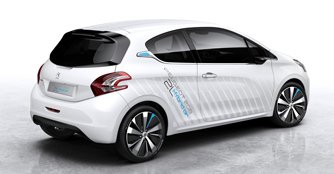Peugeot's 208 HYbrid Air 2L Demonstrator returns 59.9km/L
14 Sep 2014|2,007 views
Peugeot continues its proactive approach to lower fuel consumption and emission levels with the showcase of its 208 HYbrid Air 2L Demonstrator at the upcoming Paris Motor Show in October. The 2L refers to 2L/100km (equivalent to 50km/L), and is based on a production version of the 82bhp rated Peugeot 208 1.2-litre PureTech Hatchback.
To achieve the excellent fuel economy, Peugeot and its project partners used technologies previously reserved for competition and luxury models. Weighing just 860kg - 100kg less than the production car - the HYbrid Air 2L Demonstrator is a mix of steel, aluminium and composites.
Carbon composites are used for the body panels, sides, doors and roof, along with the coil springs - which not only provide a lighter weight - but also provide a positive impact on dynamic handling.
The standard powertrain has been replaced by a hybrid drive system featuring a mix of petrol and compressed air. HYbrid Air technology combines two types of energy to achieve greater efficiency depending on the driving conditions. The compressed air is used to assist and even replace the petrol engine to enable maximum efficiency during transition phases, such as acceleration and starts.
The hydraulic system features bespoke epicyclic transmission to strike the right balance between the two different energy sources. This replaces the manual transmission to enable automatic shifting.
In Air (ZEV) mode, the car runs on compressed air alone. This method of driving does not consume fuel and gives off no CO2 emissions, making it ideal for urban environments. In Petrol mode, the car is powered only by the 1.2-litre petrol engine. The Combined mode is designed for transition phases in urban environments, such as standing starts and acceleration. It draws on the two energy sources in proportions adjusted to achieve optimal fuel consumption.
The compressed-air tank is recharged when slowing down (while braking or taking the foot off the pedal) or by part use of the energy developed by the three-cylinder petrol engine to compress the air. Both methods can achieve maximum pressure in just 10 seconds.
Peugeot continues its proactive approach to lower fuel consumption and emission levels with the showcase of its 208 HYbrid Air 2L Demonstrator at the upcoming Paris Motor Show in October. The 2L refers to 2L/100km (equivalent to 50km/L), and is based on a production version of the 82bhp rated Peugeot 208 1.2-litre PureTech Hatchback.
To achieve the excellent fuel economy, Peugeot and its project partners used technologies previously reserved for competition and luxury models. Weighing just 860kg - 100kg less than the production car - the HYbrid Air 2L Demonstrator is a mix of steel, aluminium and composites.
Carbon composites are used for the body panels, sides, doors and roof, along with the coil springs - which not only provide a lighter weight - but also provide a positive impact on dynamic handling.
The standard powertrain has been replaced by a hybrid drive system featuring a mix of petrol and compressed air. HYbrid Air technology combines two types of energy to achieve greater efficiency depending on the driving conditions. The compressed air is used to assist and even replace the petrol engine to enable maximum efficiency during transition phases, such as acceleration and starts.
The hydraulic system features bespoke epicyclic transmission to strike the right balance between the two different energy sources. This replaces the manual transmission to enable automatic shifting.
In Air (ZEV) mode, the car runs on compressed air alone. This method of driving does not consume fuel and gives off no CO2 emissions, making it ideal for urban environments. In Petrol mode, the car is powered only by the 1.2-litre petrol engine. The Combined mode is designed for transition phases in urban environments, such as standing starts and acceleration. It draws on the two energy sources in proportions adjusted to achieve optimal fuel consumption.
The compressed-air tank is recharged when slowing down (while braking or taking the foot off the pedal) or by part use of the energy developed by the three-cylinder petrol engine to compress the air. Both methods can achieve maximum pressure in just 10 seconds.
Latest COE Prices
July 2025 | 1st BIDDING
NEXT TENDER: 23 Jul 2025
CAT A$101,102
CAT B$119,600
CAT C$66,689
CAT E$118,500
View Full Results Thank You For Your Subscription.



















